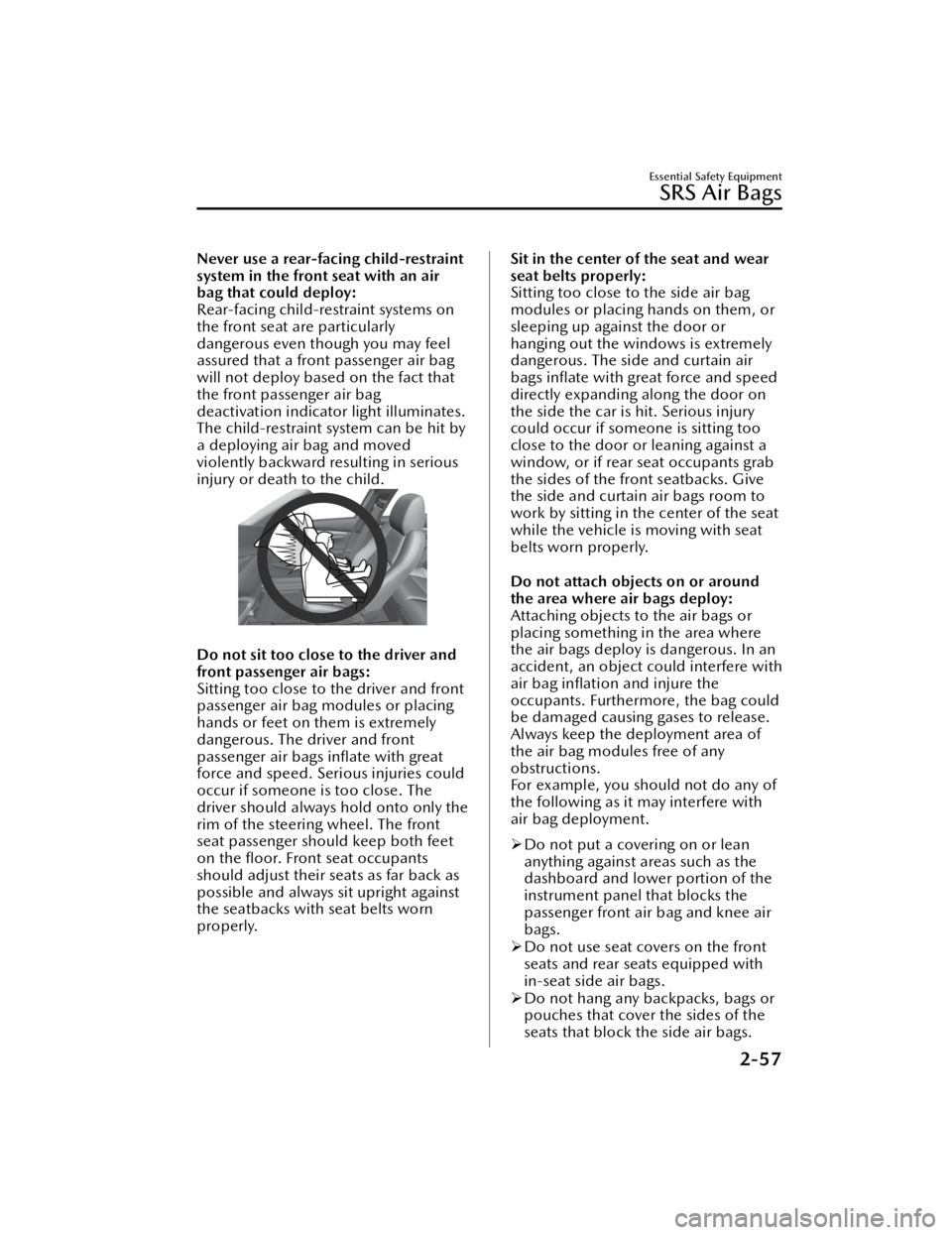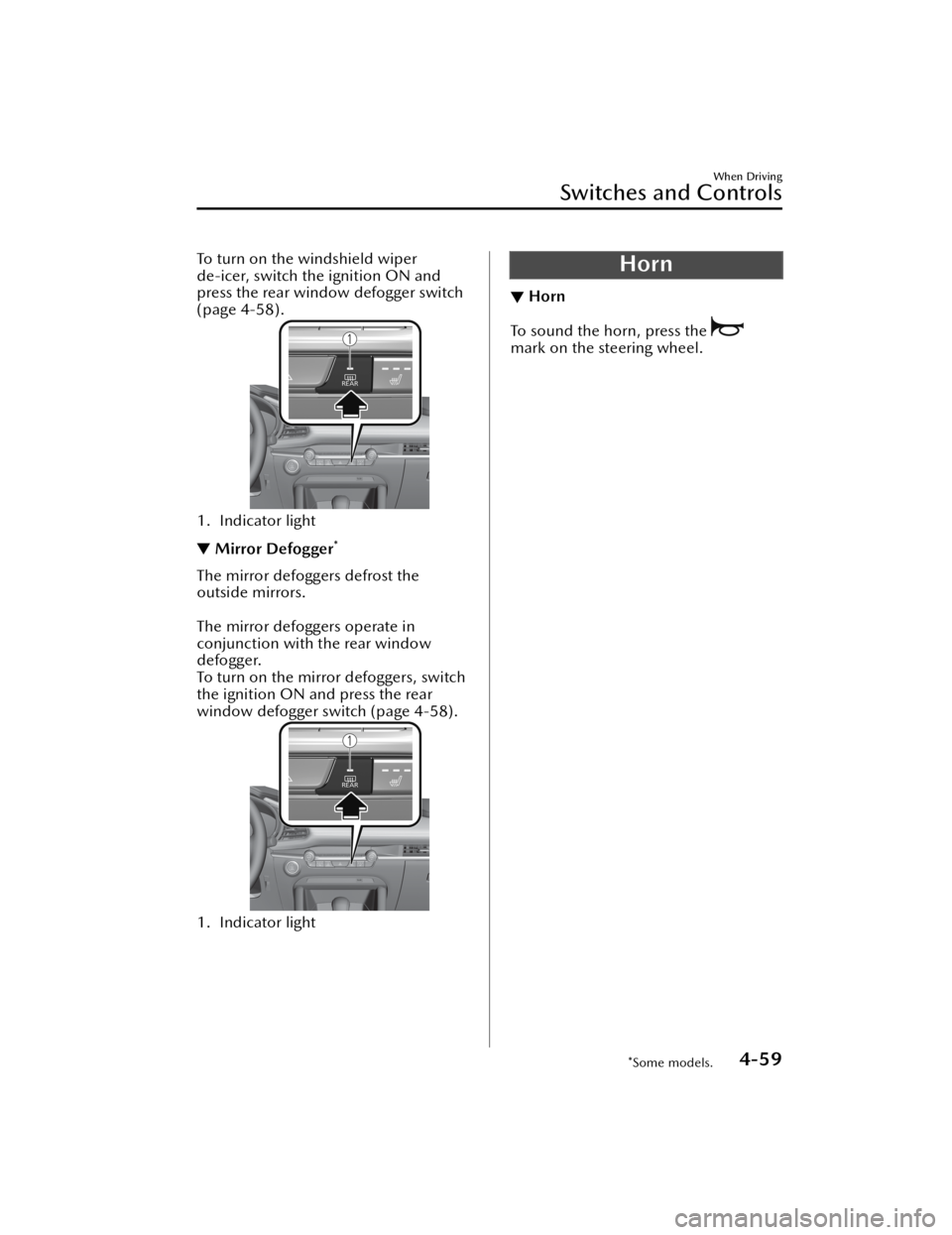steering wheel MAZDA MODEL 3 HATCHBACK 2021 User Guide
[x] Cancel search | Manufacturer: MAZDA, Model Year: 2021, Model line: MODEL 3 HATCHBACK, Model: MAZDA MODEL 3 HATCHBACK 2021Pages: 612, PDF Size: 89.06 MB
Page 71 of 612

Never use a rear-facing child-restraint
system in the front seat with an air
bag that could deploy:
Rear-facing child-restraint systems on
the front seat are particularly
dangerous even though you may feel
assured that a front passenger air bag
will not deploy based on the fact that
the front passenger air bag
deactivation indicator light illuminates.
The child-restraint system can be hit by
a deploying air bag and moved
violently backward resulting in serious
injury or death to the child.
Do not sit too close to the driver and
front passenger air bags:
Sitting too close to the driver and front
passenger air bag modules or placing
hands or feet on them is extremely
dangerous. The driver and front
passenger air bags inflate with great
force and speed. Serious injuries could
occur if someone is too close. The
driver should always hold onto only the
rim of the steering wheel. The front
seat passenger should keep both feet
on the floor. Front seat occupants
should adjust their seats as far back as
possible and always sit upright against
the seatbacks with seat belts worn
properly.
Sit in the center of the seat and wear
seat belts properly:
Sitting too close to the side air bag
modules or placing hands on them, or
sleeping up against the door or
hanging out the windows is extremely
dangerous. The side and curtain air
bags in flate with great force and speed
directly expanding along the door on
the side the car is hit. Serious injury
could occur if someone is sitting too
close to the door or leaning against a
window, or if rear seat occupants grab
the sides of the front seatbacks. Give
the side and curtain air bags room to
work by sitting in the center of the seat
while the vehicle is moving with seat
belts worn properly.
Do not attach objects on or around
the area where air bags deploy:
Attaching objects to the air bags or
placing something in the area where
the air bags deploy is dangerous. In an
accident, an object could interfere with
air bag in flation and injure the
occupants. Furthermore, the bag could
be damaged causing gases to release.
Always keep the deployment area of
the air bag modules free of any
obstructions.
For example, you should not do any of
the following as it may interfere with
air bag deployment.
Do not put a covering on or lean
anything against areas such as the
dashboard and lower portion of the
instrument panel that blocks the
passenger front air bag and knee air
bags.
Do not use seat covers on the front
seats and rear seats equipped with
in-seat side air bags.
Do not hang any backpacks, bags or
pouches that cover the sides of the
seats that block the side air bags.
Essential Safety Equipment
SRS Air Bags
2-57
Mazda3_8JM2-EA -20H_Edition1_new 2020-7-10 17:21:34
Page 73 of 612

Do not modify a front door or leave
any damage unrepaired. Always have
an Authorized Mazda Dealer inspect a
damaged front door:
Modifying a front door or leaving any
damage unrepaired is dangerous. Each
front door has a side crash sensor as a
component of the supplemental
restraint system. If holes are drilled in a
front door, a door speaker is left
removed, or a damaged door is left
unrepaired, the sensor could be
adversely affected causing it to not
detect the pressure of an impact
correctly during a si de collision. If a
sensor does not detect a side impact
correctly, the side and curtain air bags
and the front seat belt pretensioner
may not operate norm ally which could
result in serious injury to occupants.
Do not modify the supplemental
restraint system:
Modifying the components or wiring of
the supplemental restraint system is
dangerous. You could accidentally
activate it or make it inoperable. Do
not make any modi fications to the
supplemental restraint system. This
includes installing trim, badges, or
anything else over the air bag modules.
It also includes installing extra
electrical equipment on or near system
components or wiring. An Authorized
Mazda Dealer can provide the special
care needed in the removal and
installation of front seats. It is
important to protect the air bag wiring
and connections to assure that the
bags do not accidentally deploy, and
that the front passenger occupant
classi fication system and the seats
retain an undamaged air bag
connection.Do not place luggage or other objects
under the front seats:
Placing luggage or other objects under
the front seats is dangerous. The
components essential to the
supplemental restraint system could be
damaged, and in the event of a side
collision, the appropriate air bags may
not deploy, which could result in death
or serious injury. To prevent damage to
the components essential to the
supplemental restraint system, do not
place luggage or other objects under
the front seats.
Do not operate a vehicle with
damaged air bag/seat belt
pretensioner system components:
Expended or damaged air bag/seat
belt pretensioner system components
must be replaced after any collision
which caused them to deploy or
damage them. Only a trained
Authorized Mazda Dealer can fully
evaluate these systems to see that they
will work in any subsequent accident.
Driving with an expended or damaged
air bag or pretensioner unit will not
a ff ord you the necessary protection in
the event of any subsequent accident
which could result in serious injury or
death.
Do not remove interior air bag parts:
Removing any components such as the
front seats, front dashboard, the
steering wheel or pa rts on the front
and rear window pillars and along the
roof edge, containing air bag parts or
sensors is dangerous. These parts
contain essential air bag components.
The air bag could accidentally activate
and cause serious injuries. Always have
an Authorized Mazda Dealer remove
these parts.
Essential Safety Equipment
SRS Air Bags
2-59
Mazda3_8JM2-EA -20H_Edition1_new 2020-7-10 17:21:34
Page 77 of 612

How the SRS Air BagsWork
▼How the SRS Air Bags Work
Your Mazda is equipped with the
following types of SRS air bags. SRS air
bags are designed to work together
with the seat belts to help to reduce
injuries during an accident.
The SRS air bags are designed to
provide further protection for
passengers in addition to the seat belt
functions. Be sure to wear seat belts
properly.
▼Front Seat Belt Pretensioners
The front seat belt pretensioners are
designed to deploy in moderate or
severe frontal, near frontal collisions.
In addition, the pretensioners operate
when a side collision or a roll-over
accident is detected. The pretensioners
operate
differently depending on what
types of air bags are equipped. For
more details about seat belt
pretensioner operation, refer to the
SRS Air Bag Deployment Criteria (page
2-67).
▼ Driver Air Bag
The driver's air bag is mounted in the
steering wheel.
When air bag crash sensors detect a
frontal impact of greater than
moderate force, the driver's air bag
in
flates quickly helping to reduce injury
mainly to the driver's head or chest
caused by directly hitting the steering
wheel.
For more details about air bag
deployment, refer to "SRS Air Bag
Deployment Criteria" (page 2-67).
(With Front Passenger Occupant
Classi fication System)
The driver's dual-stage air bag controls
air bag in flation in two energy stages.
During an impact of moderate severity,
the driver's air bag deploys with lesser
energy, whereas during more severe
impacts, it deploys with more energy.
Essential Safety Equipment
SRS Air Bags
2-63
Mazda3_8JM2-EA -20H_Edition1_new 2020-7-10 17:21:34
Page 84 of 612

Limitations to roll-over detection
(With Front Passenger Occupant
Classification System):
The following illustration is an example
of an accident that may not be
detected as a roll-over accident.
Therefore, the front seat belt
pretensioners and curtain air bags may
not deploy.
Pitch end over end
Driver and Front
Pa s s e n g e r O cc u p a n t
Classi fication System
*
▼ Driver and Front Passenger
Occupant Classi
fication System
First, please read "Supplemental
Restraint System (SRS) Precautions"
(page 2-55) carefully.
▼ Driver Seat Slide Position Sensor
Your vehicle is equipped with a driver
seat slide position sensor as a part of
the supplemental restraint system. The
sensor is located under the driver seat.
The sensor determines whether the
driver seat is fore or aft of a reference
position and sends the seat position to
the diagnostic module (SAS unit).
The SAS unit is designed to control the
deployment of the driver air bag
depending on how close the driver
seat is to the steering wheel.
The air bag/front seat belt
pretensioner system warning light
fl
ashes if the sensor has a possible
malfunction (page 2-66).
Essential Safety Equipment
SRS Air Bags
2-70*Some models.
Mazda3_8JM2-EA -20H_Edition1_new 2020-7-10 17:21:34
Page 135 of 612

WARNING
Never stop the engine when going
down a hill:
Stopping the engine when going down
a hill is dangerous. This causes the loss
of power steering and power brake
control, and may cause damage to the
drivetrain. Any loss of steering or
braking control could cause an
accident.
Hazardous Driving
▼Hazardous Driving
WARNING
Be extremely careful if it is necessary
to downshift on slippery surfaces:
Downshifting into lower gear while
driving on slippery surfaces is
dangerous. The sudden change in tire
speed could cause the tires to skid.
This could lead to loss of vehicle
control and an accident.
When driving on ice or in water, snow,
mud, sand, or similar hazards:
Be cautious and allow extra distance
for braking.
Avoid sudden braking and sudden
maneuvering.
Do not pump the brakes. Continue
to press down on the brake pedal.
Refer to Antilock Brake System (ABS)
on page 4-77.
If you get stuck, select a lower gear
and accelerate slowly. Do not spin
the front wheels.
For more traction in starting on
slippery surfaces such as ice or
packed snow, use sand, rock salt,
chains, carpeting , or other nonslip
material under the front wheels.
NOTE
Use snow chains only on the front
wheels.
Before Driving
Driving Tips
3-45
Mazda3_8JM2-EA
-20H_Edition1_new 2020-7-10 17:21:34
Page 182 of 612

WARNING
Keep your hands on the steering
wheel rim when using fingers on the
steering shift switches:
Putting your hands inside the rim of
the steering wheel when using the
steering shift switches is dangerous. If
the driver's air bag were to deploy in a
collision, your hands could be
impacted causing injury.
NOTE
When driving slowly, the gears may
not shift up.
Do not drive the vehicle with the
tachometer needle in the RED ZONE
while in manual shift mode. In
addition, manual shift mode
switches to automatic shift mode
while the accelerator pedal is
completely depressed.
This function is canceled while the
DSC is turned o ff. However, if the
vehicle is continuously driven at a
high rpm, the gears may
automatically shift up to protect the
engine.
The steering shift switch can be used
temporarily even if the selector lever
is in the D position while driving. In
addition, it returns to automatic shift
mode when the UP switch (+/OFF)
is pulled rearward for a su fficient
amount of time.
▼ Manually Shifting Down
You can shift gears down by operating
the selector lever or the steering shift
switches
*.
M6 → M5 → M4 → M3 → M2 → M1
Using selector lever
To shift down to a lower gear, tap the
selector lever forward – once.
Using steering shift switch*
To shift down to a lower gear with the
steering shift switches, pull the DOWN
switch (–) toward you once with your
fingers.
1. DOWN switch (–)
When Driving
Automatic Transmission
4-40*Some models.
Mazda3_8JM2-EA -20H_Edition1_new 2020-7-10 17:21:34
Page 183 of 612

WARNING
Do not use engine braking on slippery
road surfaces or at high speeds:
Shifting down while driving on wet,
snowy, or frozen roads, or while
driving at high speeds causes sudden
engine braking, which is dangerous.
The sudden change in tire speed could
cause the tires to skid. This could lead
to loss of vehicle control and an
accident.
Keep your hands on the steering
wheel rim when using fingers on the
steering shift switches:
Putting your hands inside the rim of
the steering wheel when using the
steering shift switches is dangerous. If
the driver's air bag were to deploy in a
collision, your hands could be
impacted causing injury.
NOTE
When driving at high speeds, the
gear may not shift down.
During deceleration, the gear may
automatically shift down depending
on vehicle speed.
When depressing the accelerator
fully, the transmission will shift to a
lower gear, depending on vehicle
speed. However, the gears do not
kickdown while the DSC is turned
o ff.
▼ Second Gear Fixed Mode
When the selector lever is moved back
+ while the vehicle speed is about 10
km/h (6.2 mph) or less, the
transmission is set in the second gear
fixed mode. The gear is
fixed in second
while in this mode for easier
acceleration from a stop and driving on
slippery roads such as snow-covered
roads.
If the selector lever is moved back + or
forward – while in the second gear
fixed mode, the mode will be
canceled.
When Driving
Automatic Transmission
4-41
Mazda3_8JM2-EA -20H_Edition1_new 2020-7-10 17:21:34
Page 201 of 612

To turn on the windshield wiper
de-icer, switch the ignition ON and
press the rear window defogger switch
(page 4-58).
1. Indicator light
▼Mirror Defogger*
The mirror defoggers defrost the
outside mirrors.
The mirror defoggers operate in
conjunction with the rear window
defogger.
To turn on the mirror defoggers, switch
the ignition ON and press the rear
window defogger switch (page 4-58).
1. Indicator light
Horn
▼Horn
To sound the horn, press the
mark on the steering wheel.
When Driving
Switches and Controls
*Some models.4-59
Mazda3_8JM2-EA
-20H_Edition1_new 2020-7-10 17:21:34
Page 213 of 612

AUTOHOLD
▼AUTOHOLD
The AUTOHOLD function automatically holds the vehicle stopped, even if you take
your foot
off the brake pedal. This function can be best used while stopped in
traffic
or at a traffic light. The brakes are released when you start driving the vehicle.
WARNING
Do not rely completely on the AUTOHOLD function:
The AUTOHOLD function is only designed to assist the brake operation while the
vehicle is stopped. Neglecting to operate the brakes and relying only on the
AUTOHOLD system is dangerous and could result in an unexpected accident if the
vehicle were to suddenly move. Operate the brakes appropriately in accordance
with the road and surrounding conditions.
Do not release your foot from the brake pedal while the vehicle is stopped on a
steep grade:
Because there is a possibility of the vehicl
e not being held in the stopped position by
the AUTOHOLD function, the vehicle may move unexpectedly and result in an
accident.
Do not use the AUTOHOLD function on slippery roads such as icy or
snow-covered roads, or unpaved roads:
Even if the vehicle is held in the stopped position by the AUTOHOLD function, the
vehicle may move unexpectedly and result in an accident. Operate the accelerator
pedal, brakes, or steering wheel appropriately as necessary.
Immediately depress the brake pedal in the following cases:
Because the AUTOHOLD function is canceled forcibly, the vehicle may move
unexpectedly and result in an accident.
“Depress Brake Pedal. Brake Hold Disabled” is displayed in the multi-information
display and the warning sound is activated at the same time.
Always apply the parking brake when parking the vehicle:
Not applying the parking brake when parking the vehicle is dangerous as the vehicle
may move unexpectedly and result in an accident. When parking the vehicle, shift
the selector lever to the P position (automatic transmission vehicle) and apply the
parking brake.
When Driving
Brake
4-71
Mazda3_8JM2-EA -20H_Edition1_new 2020-7-10 17:21:34
Page 223 of 612

Drive Selection*
▼Drive Selection
Drive selection is a system to switch
the vehicle's drive mode. When the
sport mode is selected, vehicle's
response against accelerator operation
is enhanced. This provides additional
quick acceleration which may be
needed to safely make maneuvers such
as lane changes, merging onto
freeways, or passing other vehicles.
CAUTION
Do not use the sport mode when
driving on slippery roads such as wet
or snow-covered roads. It may cause
tire slipping.
NOTE
When the sport mode is selected,
driving at higher engine speeds
increases and it may increase fuel
consumption. Mazda recommends
that you cancel the sport mode on
normal driving.
Drive mode cannot be switched in
the following conditions:
ABS/TCS/DSC is operatingCruise control* is operating.The Mazda Radar Cruise Control
with Stop & Go function (MRCC
with Stop & Go function) System
*
is operating.Tra
ffic Jam Assist (TJA) is operating.Steering wheel is being operated
abruptly
▼ Drive Selection Switch
Press the drive selection switch forward
(SPORT) to select the sport mode.
Pull the drive selection switch back
(OFF) to cancel the sport mode.
NOTE
In the following cases, the drive
selection is canceled.
The ignition is switched OFF.Mazda Radar Cruise Control with
Stop & Go function (MRCC with
Stop & Go function) System/cruise
control is set.
Tra
ffic Jam Assist (TJA) is set.Depending on the driving conditions
when sport mode is selected, the
vehicle may perform shift-down or
slightly accelerate.
When Driving
Drive Selection
*Some models.4-81
Mazda3_8JM2-EA -20H_Edition1_new 2020-7-10 17:21:34